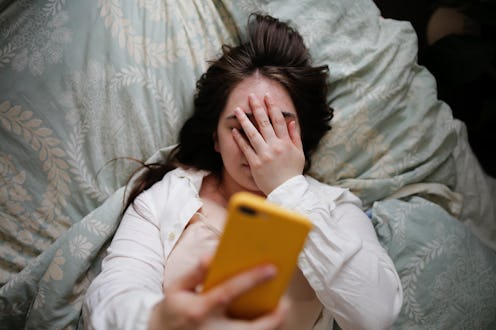Wellness
TikTok’s “Cognitive Shuffling” Hack Can Help You Fall Asleep In Minutes
For when your brain decides to run through your to-do list at 11 p.m.

In a perfect world, you’d climb into bed, rest your head on your pillow, and slowly drift off to dreamland. In reality, your brain chooses 11 p.m. as the perfect time to remember every embarrassing moment, worry, fear, and item on your to-do list — and suddenly it’s impossible to fall asleep.
To cope with this noisy pre-bed brain chatter, it’s tempting to distract yourself with something external, like social media or a comfort TV show. But the best trick might be to beat your brain at its own game with a round of cognitive shuffling. This sleep hack took off on TikTok thanks to creator @joelchesters, and it now has more than 37 million views.
The idea is to repeat random words in your head as a way to drown out your worries — the more random, the better. According to Dr. Shelby Harris, Psy.D., C.BSM, a licensed clinical psychologist, sleep expert, and director of sleep health at Sleepopolis, cognitive shuffling offers a structured approach to managing your thoughts, and it really can have a calming effect on the brain.
Here’s what to know and how to try the technique for yourself.
The Sleep Struggle Is Real
According to Harris, it’s common to experience racing thoughts or a busy mind as you try to fall asleep, especially when you’re dealing with stress, anxiety, or worries — both big and small.
“This happens because, as we wind down for the night, our minds are no longer occupied with the activities and tasks of the day,” she says. “This lack of distraction can make our underlying concerns and stressors more prominent in our thoughts, making it challenging to fall asleep.”
Our usual go-to coping mechanisms don’t help, either. Even though it feels good to drown out racing thoughts with something distracting, like TikTok or a Real Housewives episode, the noise, sound, bright lights, and constant stimulation actually make it tougher to fall and stay asleep.
The Magic Of Cognitive Shuffling
On TikTok, the mind-quieting method has garnered rave reviews. User @neuroqueercoach tried cognitive shuffling and had lots of success with it, noting that it “scrambles your thoughts” in a way that makes it hard for your brain to focus on daily worries and annoyances, like to-do lists, problem-solving, over-evaluation, and planning.
Creator @maedah.davami also gave it a try and said that it fixed her insomnia. While it might seem like cognitive shuffling would increase your overthinking, she said it actually helps her avoid it because the words, and the order you think of them in, don’t make any sense.
According to Harris, that’s exactly the point. Cognitive shuffling helps calm racing thoughts so that you actually feel peaceful and relaxed enough to sleep. It works by distracting your brain with random, easy-to-imagine objects, sort of like a visualization — so you’re preoccupied instead of stressed.
How To Shuffle
There are a few ways to try cognitive shuffling, but the main goal is always the same: Distract your chatty brain at all costs. On TikTok, the go-to technique is to name random things one right after the other, and the more arbitrary, the better.
To give it a go, lie in bed — preferably in the dark with no other distractions — and begin to say words in your head, like elephant, bread, yo-yo, candle, etc. It isn’t a race or a game, so there’s no need to go fast or to try too hard. Just allow yourself to shuffle through a list of words.
If you want a bit more structure, give yourself a category. “For example, you might choose a word like ‘pillow’ and then come up with other objects that start with the same letter as a way to engage your mind and gradually drift into a state of sleepiness,” Harris says.
A third option is to go through the alphabet and name things for each letter. Start with A and see how far you can make it until you fall asleep.
Troubleshooting The Method
While many people on TikTok noticed that they fell asleep within minutes after cognitive shuffling, it doesn’t magically work for everyone. Remember, it's designed to help calm racing thoughts so that you can reduce the amount of time it takes to fall asleep at night, says Harris.
Cognitive shuffling is a nifty way to keep stressful thoughts at bay, but according to Harris, it’s important not to force it, since that’ll just give you more stress. If your mind continues to race late into the night, she recommends trying other relaxation techniques, like deep breathing.
It might also help to get up and do something relaxing and quiet, like reading, until your eyelids get heavy. Once they do, you can slip back between your sheets and (hopefully) catch some Zzzs.
Studies referenced:
Chellappa, SL. (2022). Sleep and anxiety: From mechanisms to interventions. Sleep Med Rev. doi: 10.1016/j.smrv.2021.101583.
Finucane, E. (2021). Does reading a book in bed make a difference to sleep in comparison to not reading a book in bed? The People's Trial-an online, pragmatic, randomised trial. Trials. 2021 Dec 4;22(1):873. doi: 10.1186/s13063-021-05831-3.
Jerath, R. (2019). Self-Regulation of Breathing as an Adjunctive Treatment of Insomnia. Front Psychiatry. doi: 10.3389/fpsyt.2018.00780.
Kaczkurkin, AN. (2021). The Association between Insomnia and Anxiety Symptoms in a Naturalistic Anxiety Treatment Setting. Behav Sleep Med. doi: 10.1080/15402002.2020.1714624.
Kalmbach, DA. (2018). The impact of stress on sleep: Pathogenic sleep reactivity as a vulnerability to insomnia and circadian disorders. J Sleep Res. doi: 10.1111/jsr.12710.
Silvani, MI. (2022). The influence of blue light on sleep, performance and wellbeing in young adults: A systematic review. Front Physiol. doi: 10.3389/fphys.2022.943108.
Sources:
Dr. Shelby Harris, Psy.D., C.BSM, licensed clinical psychologist, sleep expert, director of sleep health at Sleepopolis.